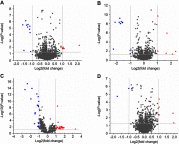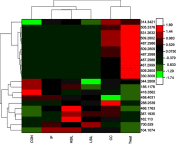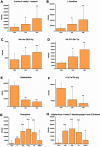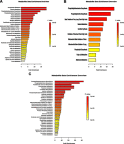New serum biomarker identification and analysis by mass spectrometry in cervical precancerous lesion and acute cervicitis in South China
- PMID: 31308751
- PMCID: PMC6613603
- DOI: 10.2147/CMAR.S205052
New serum biomarker identification and analysis by mass spectrometry in cervical precancerous lesion and acute cervicitis in South China
Abstract
Background: According to the statistics of WHO/IARC, cervical cancer (CC) has become the fourth malignant cancer of female worldwide and it is one of the main causes of death of women in developing countries. Purpose: Potential plasma and metabolic biomarkers for CC precancerous lesions and cervicitis were indicated by LC-MS techniques, and their underlying mechanisms and functions were analyzed. Methods: Plasma samples were selected from healthy people (control), low-grade squamous intraepithelial lesions (LSIL), high-grade squamous intraepithelial lesions (HSIL), CC, and post-treatment patients. All polypeptide types and sequences were detected by LC-MS/MS and the results were normalized by using Pareto-scaling. Potential metabolic biomarkers were screened by applying MetaboAnalyst 4.0 software and XCMS software, and analysis of variance and enrichment analysis were performed. Metabolic pathway analysis and functional enrichment analysis were used to further investigate the significance and pathological mechanisms of potential biomarkers. Results: Compared with healthy people, 9 differentially expressed metabolites were screened, 4 of which were up-regulated and 5 were down-regulated. LSIL group screened 7 differentially expressed metabolites, 5 of which were up-regulated and 2 were down-regulated; CC group screened 12 differentially expressed metabolites were screened, of which 9 were up-regulated and 3 were down-regulated. Eight differentially expressed metabolites were screened in the IF group, of which 5 showed up-regulation and 3 showed down-regulation. In functional enrichment analysis, differential metabolism was found to be associated with addition and coagulation cascades. Among all potential biomarkers, 2-amino-3-methyl-1-butanol, L-carnitine, Asn Asn Gln Arg, Ala Cys Ser Trp, Soladulcidine, Ala Ile Gln Arg, 2-amino-3 -Methyl-1-butanol, L-carnitine, Asn Asn Gln Arg, Ala Cys Ser Trp, Soladulcidine, Ala Ile Gln Arg can be used as predictors of precancerous lesions at different stages of CC. Among all biomarkers, 6α-fluoro-11β1,17-dihydroxypren-4-ene-3,20-dione has higher expression in the CC and HSIL groups and lower expression in the treatment group. Conclusion: By applying molecular markers to assess the progression of the disease, the accuracy and specificity of the diagnosis can be improved, which has certain prospects in clinical applications.
Keywords: LC-MS; acute cervicitis; cervical precancerous lesion; metabonomics; serum biomarkers.
Conflict of interest statement
The authors report no conflicts of interest in this work.
Figures





Similar articles
-
[LC-MS/MS-based screening of new protein biomarkers for cervical precancerous lesions and cervical cancer].Nan Fang Yi Ke Da Xue Xue Bao. 2019 Jan 30;39(1):13-22. doi: 10.12122/j.issn.1673-4254.2019.01.03. Nan Fang Yi Ke Da Xue Xue Bao. 2019. PMID: 30692061 Free PMC article. Chinese.
-
Potential serum metabolites and long-chain noncoding RNA biomarkers for endometrial cancer tissue.J Obstet Gynaecol Res. 2023 Feb;49(2):725-743. doi: 10.1111/jog.15494. Epub 2022 Dec 12. J Obstet Gynaecol Res. 2023. PMID: 36510632
-
Primary structure of murine major histocompatibility complex alloantigens: amino acid sequence of the amino-terminal one hundred and seventy-three residues of the H-2Kb glycoprotein.Biochemistry. 1980 Jan 22;19(2):306-15. doi: 10.1021/bi00543a009. Biochemistry. 1980. PMID: 6986168
-
Amino acid sequence of human tumor derived angiogenin.Biochemistry. 1985 Sep 24;24(20):5486-94. doi: 10.1021/bi00341a031. Biochemistry. 1985. PMID: 2866794
-
CADM1, MAL, and miR124 Promoter Methylation as Biomarkers of Transforming Cervical Intrapithelial Lesions.Int J Mol Sci. 2019 May 7;20(9):2262. doi: 10.3390/ijms20092262. Int J Mol Sci. 2019. PMID: 31067838 Free PMC article.
Cited by
-
Establishment and Validation of a Liquid Chromatography-Tandem Mass Spectrometry Method for the Determination of Tigecycline in Critically Ill Patients.Int J Anal Chem. 2020 Dec 29;2020:6671392. doi: 10.1155/2020/6671392. eCollection 2020. Int J Anal Chem. 2020. PMID: 33456470 Free PMC article.
-
Plasma-Based Metabolomics Profiling of High-Risk Human Papillomavirus and their Emerging Roles in the Progression of Cervical Cancer.Biomed Res Int. 2022 Nov 3;2022:6207701. doi: 10.1155/2022/6207701. eCollection 2022. Biomed Res Int. 2022. PMID: 36389117 Free PMC article.
References
-
- Ferlay J, Soerjomataram I, Ervik M, et al. Cancer incidence and mortality worldwide: IARC CancerBase. Abdom Radiol (NY). 2012;42(1):124–140. doi:10.1007/s00261-016-0901-x - DOI
LinkOut - more resources
Full Text Sources
Miscellaneous

